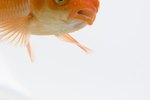
Several related fish species in the wild have a unique method of protecting themselves from predators. The Tetraodontidae and the Diodontidae both puff themselves up with air or water in order to scare off the fish that want to eat them. Their more commonly known names include the globefish, porcupinefish, and pufferfish. Porcupinefish have spines, however, and are part of the Diodontidae family while pufferfish are smooth-skinned and of the Tetraodontidae. Both families evolved to puff up in the same ways.
Pre-Puffing
Pufferfish know how to inflate themselves instinctively from hatching, even if they cannot utilize it to its full effect until they grow to adulthood. When frightened, the puffer unhinges his jaw in order to widen his mouth. This allows him more room to suck in around 35 large gulps of water in approximately 14 seconds. Note that the water, or air if the fish is out of water, is not in the puffer's stomach at this time.
The Inflation
If the puffer finds the threat has not gone away once he has sucked in all the water he can, he moves into the inflation stage. His stomach and skin are highly stretchy and he has no rib cage to get in the way. At the end of his water-sucking, he stops up his mouth with a valve meant to close his esophagus. Using muscles in his body that evolution has developed over time, he "coughs" the water toward the front of his mouth and down the open esophagus into the stomach. The stomach inflates so the puffer becomes up to three times his normal size.
Deflation
While inflated, a pufferfish loses mobility further than when he began. In fact, a puffer fish inflates defensively because he cannot outrun his enemies. Once he feels the danger has passed, he calms and forces the water out of his stomach in several stages until he returns to his original size. The water is expelled in a reverse of how it entered. Too much air trapped in his stomach can prevent a puffer from expelling the water, which can be fatal.
Puffing Evolution
Pufferfish learned how to inflate themselves in a two-step process, according to scientists. The first step, coughing, developed when these fish ate slimy creatures and needed to get rid of the shells and coating in their throats. In order to do so, pufferfish ancestors closed their gill slits and used muscles on each side of their heads to bring in water, and then quickly expel it to clean their throats. In the second step the fish strengthened their coughing muscles in order to jet water out faster, and tightened their mouths so the water was more focused, like out of a waterhose nozzle. With this practice, the fish overturned sea urchins to get to their soft bellies. Instead of forcing water out, these same muscles bring water into the puffer instead, and then expel it once he feels safe again.
References
Photo Credits
-
Hemera Technologies/Photos.com/Getty Images
Writer Bio
Dondi Ratliff is a certified secondary English teacher in Texas. Her articles typically cover topics regarding animals both wild and domesticated. Ratliff holds a Bachelor of Arts in English from Tarleton State University, a Master of Arts in teaching from Texas Woman's University, and a Master of Arts in English from Tarleton State University.



